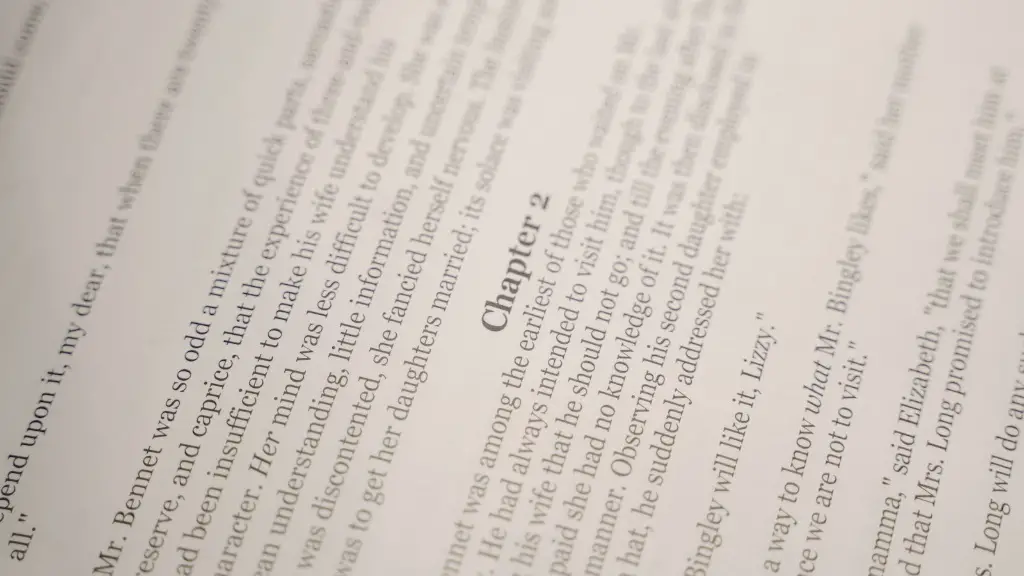Oscar Wilde, a 19th century Irish writer and poet, was a true Renaissance man. He was known for his flamboyant personality, his biting wit and his prolific writing. He wrote in a wide variety of genres including plays, novels, essays, and poems. Wilde’s most famous works are his plays The Importance of Being Ernest and Lady Windermere’s Fan. His novel The Picture of Dorian Gray is often seen as a cautionary tale about vanity and excess. Wilde’s writing career lasted just over a decade, but his work is still regarded as some of the best of the era.
Wilde is typically associated with the Aesthetic Movement in England and Ireland, a movement that sought to free art from materialism and to pursue beauty through art. Wilde is renowned for his witty bon mots, like ‘To love oneself is the beginning of a life-long romance.’ He was often seen as a celebrity in 19th century London and was notorious for his one-liners. He was also an advocate for individualism and freedom of expression, two values which were not widely accepted in the Victorian-era.
Wilde’s most famous plays, The Importance of Being Earnest and Lady Windermere’s Fan, both poke fun at the societal conventions of the time. These plays emphasize the absurdity of society’s platitudes on love, marriage and manners. Through both plays Wilde attempted to challenge the notion of Victorian morality and encourage individual freedom. His satire was often subtle, but his critique of his culture was powerful.
The Picture of Dorian Gray was published in 1890 and was one of the most controversial works of the Victorian era. The novel follows the title character as he sells his soul to remain eternally young as his portrait gradually ages. The novel warns against the consequences of selfishness and vanity by exploring the relationship between art and morality. To contemporary readers, Dorian Gray still serves as a powerful cautionary tale.
Oscar Wilde’s writing continues to be admired and discussed to this day. His work has been adapted into multiple plays and movies, which often capture the full scope of his wit and subtle social critiques. Although the themes of Wilde’s works are often timeless and his bon mots still quoted, his unique flair ensures that his works will never seem dated and will continue to captivate generations to come.
Style and Technique
Oscar Wilde’s writing was distinguished by its combination of wit and refinement, often jokingly referred to as ‘wine in a teacup.’ He frequently employed puns, irony, and paradox to maintain his signature wit, often using double entendre and rhetorical figures. Wilde’s writing sometimes borders on the absurd, but he expertly tweaks it to retain a sharpness and intelligence, as his wit is not simply delivered but crafted.
Wilde’s prose style is known for its flamboyancy, which is often composed of long and complex sentences full of allusion and literary imagery. He also used repetition of phrases and other literary devices such as parallelism. He often created new words, or wrote in the style of two different eras, such as writing in the Victorian style in The Picture of Dorian Gray but with occasional bursts of eloquence in Old English language.
Wilde was also highly skilled in combining comedy, tragedy and romance in his works. He often used comic reversals and situational irony to great effect. He could seamlessly link the comic and the serious, often using those transitions to powerful emotional effects. He was also able to express deep ambivalence without relying on symbols to convey the characters’ psychological states.
Legacy
Oscar Wilde’s prolific and revolutionary writing has had a lasting influence on literature. Many of his works are still widely discussed and his unique style has been referenced by many authors. Wilde’s plays in particular were highly influential, introducing ideas and themes that were not widely accepted at the time. His short stories established him as a master of the genre and remain widely read to this day.
Wilde is also widely credited with introducing a new level of intelligence and wit to the literary world. His works were praised for their clever use of irony and satire as well as their refusal to shy away from more difficult topics. As he was writing before the rise of modernism and postmodernism, Wilde’s work often provides a bridge between the two eras, providing insight into the conflict between Victorian and modernist sensibilities.
Ultimately, Wilde’s writing has stood the test of time and has earned him a place as one of the most respected figures of 19th century literature. To this day his work continues to be widely studied, referenced and admired. In spite of his life’s controversies, his writing remains adored by many.
Criticisms
Although Wilde’s writing was widely acclaimed in its time, contemporary critics have noticed a number of flaws in his work. For example, some have argued that Wilde’s writing often relies too heavily on references to other authors, making it difficult for readers unfamiliar with these references to follow the story. The Picture of Dorian Gray in particular is noted for its allusions to Greek mythology and Gothic literature that can be difficult to interpret.
Other criticisms of Wilde’s writing center upon his portrayal of gender and sexuality. Although Lady Windermere’s Fan, for example, is praised for its anti-patriarchal themes, some have argued that Wilde’s female characters take a backseat to his male ones, and that his depiction of female sexuality is often one-dimensional. Similarly, some have argued that Wilde does not adequately explore other facets of sexuality, such as homosexuality.
Lastly, some believe that Wilde’s writing relies too heavily on comedy. His prose is often seen as superficial and lacking in depth when compared to other writers of the time, such as George Eliot. His use of puns and jokes is sometimes seen as detracting from the emotional resonance of his works and making them overly cerebral.
Reception
When Oscar Wilde first emerged into the literary world, he was highly praised for his unique wit and intelligence. His plays were celebrated and his novel The Picture of Dorian Gray was widely viewed as a masterpiece. Wilde quickly became a celebrity and the intellectual darling of London society.
Subsequent generations have continued to herald Wilde as one of the most important figures of 19th century literature. His work is widely taught in schools and universities and has been adapted into plays, operas, movies, and television series. His works have been widely translated into multiple languages, allowing his message to be heard around the world.
Wilde’s wit and spirit captivated readers from the moment of his debut and has remained so to this day. His life and work have been widely studied and become a cornerstone of popular culture. His enduring fame speaks volumes about the power of his writing, and proves that his work will remain both relevant and affecting for generations to come.
Themes and Ideas
In his works, Wilde often addresses the ideas of personal freedom and individualism. His works often challenge the conventions of society and explore topics that were seen as daring or controversial. Many of Wilde’s works focus on the idea of love, often exploring unconventional forms of this emotion. Society’s restrictions regarding romantic and sexual relationships are sometimes the targets of his satire.
Wilde’s work also explores the notion of morality versus pleasure. The Picture of Dorian Gray is a perfect example of this theme, which is explored in both a moral sense, as Dorian’s vanity leads to unpleasant consequences, and in terms of human behavior, as Dorian struggles to reconcile his pleasure-seeking with morality. Dorian’s internal conflict is often seen as a representation of the conflict between pleasure and morality.
Most of Wilde’s works also contain elements of horror. In The Picture of Dorian Gray, the mysterious emergence of Dorian’s portrait is often seen as a Gothic motif, and in Lady Windermere’s Fan, the play’s dark undertones and sudden endings often shock audiences into attention. Horror and suspense are often used by Wilde to emphasize the tension between the conventional and the unconventional.
Additionally, Wilde’s works often use fantasy and whimsical elements to challenge reality. His works often blur the lines between what is real and what is fantasy, often relying on surreal elements to explore deeper social and political messages. His works are often seen as critiques not just of his own society, but of the societies of others.





